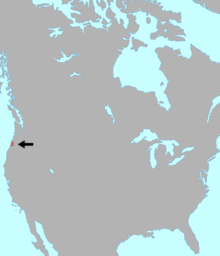Alsea language
Alsea or Alsean (also Yakonan) was two closely related speech varieties spoken along the central Oregon coast. They are sometimes taken to be different languages, but it is difficult to be sure given the poor state of attestation; Mithun believes they were probably dialects of a single language.[2]
| Alsea | |
|---|---|
| Alsea-Yaquina / Yakonan | |
| Pronunciation | /ˈælsiː/ |
| Region | Oregon |
| Ethnicity | Alsea people, Yaquina people |
| Extinct | 1942, with the death of John Albert |
Coast Oregon Penutian ?
| |
| Dialects |
|
| Language codes | |
| ISO 639-3 | aes |
| Glottolog | alse1251[1] |
 Pre-contact distribution of Alsean | |
Varieties
- Alsea (Alséya) (†)
- Yaquina (Yakwina, Yakona) (†)
Both are now extinct.
The name Alsea derives from the Coosan name for them, alsí or alsí·, and the Marys River Kalapuyan name for them, alsí·ya. Alsea was last recorded in 1942 from the last speaker, John Albert, by J. P. Harrington.
The name Yaquina derives from the Alsean name for the Yaquina Bay and the Yaquina River region, yuqú·na. Yaquina was last recorded in 1884 by James Owen Dorsey.
Alsea is usually considered to belong to the Penutian phylum, and may form part of a Coast Oregon Penutian subgroup together with Siuslaw and the Coosan languages.[3] Numerous lexical resemblances between Alsea and the Northern Wintuan languages, however, are more likely the result of borrowing about 1,500 years ago when the (Northern) Wintuan speech community appears to have been located in Oregon.[4]
Sounds
Consonants
Alsea had 34 consonants:[2]
| Bilabial | Alveolar | Alveo- palatal |
Palatal | Velar | Uvular | Glottal | ||||||
|---|---|---|---|---|---|---|---|---|---|---|---|---|
| plain | lateral | plain | labialized | plain | labialized | plain | labialized | |||||
| Stop | plain | p | t | k | kʷ | q | qʷ | |||||
| ejective | p’ | t’ | k’ | k’ʷ | q’ | q’ʷ | ʔ | |||||
| Affricate | plain | tɕ | ||||||||||
| ejective | tɬ’ | tɕ’ | ||||||||||
| Fricative | ɬ | ɕ | x | xʷ | χ | χʷ | h | (hʷ) | ||||
| Nasal | plain | m | n | |||||||||
| glottalized | m’ | n’ | ||||||||||
| Approximant | plain | l | j | w | ||||||||
| glottalized | l’ | j’ | w’ | |||||||||
Vowels
Three vowels are listed as /a, i, u/. Long vowel variants of /i, u/ are [eː, oː]. A mid vowel /ə/ occurs as a phonetically inserted vowel sound.[5]
References
- Hammarström, Harald; Forkel, Robert; Haspelmath, Martin, eds. (2017). "Alsea-Yaquina". Glottolog 3.0. Jena, Germany: Max Planck Institute for the Science of Human History.
- Mithun, Marianne. (1999). The languages of Native North America. Cambridge: Cambridge University Press. ISBN 0-521-23228-7 (hbk); ISBN 0-521-29875-X
- Grant, Anthony P. (1997). "Coast Oregon Penutian: Problems and Possibilities". International Journal of American Linguistics. 63 (1): 144–156. JSTOR 1265867.
- Golla, Victor (1997). "The Alsea-Wintuan Connection". International Journal of American Linguistics. 63 (1): 157–170. JSTOR 1265868.
- Buckley, Eugene (2007). "Vowel–Sonorant Metathesis in Alsea". International Journal of American Linguistics. 73 (1): 1–39. doi:10.1086/518333. JSTOR 10.1086/518333.
- Frachtenberg, Leo Joachim (1920). Alsea texts and myths. Washington: Govt. Printing Office. Retrieved 13 January 2020.
Further reading
- Alsea Indian Language (Yaquina, Yakona, Alsean, Alse)
- Campbell, Lyle. (1997). American Indian languages: The historical linguistics of Native America. New York: Oxford University Press. ISBN 0-19-509427-1.
- OLAC resources in and about the Alsea language